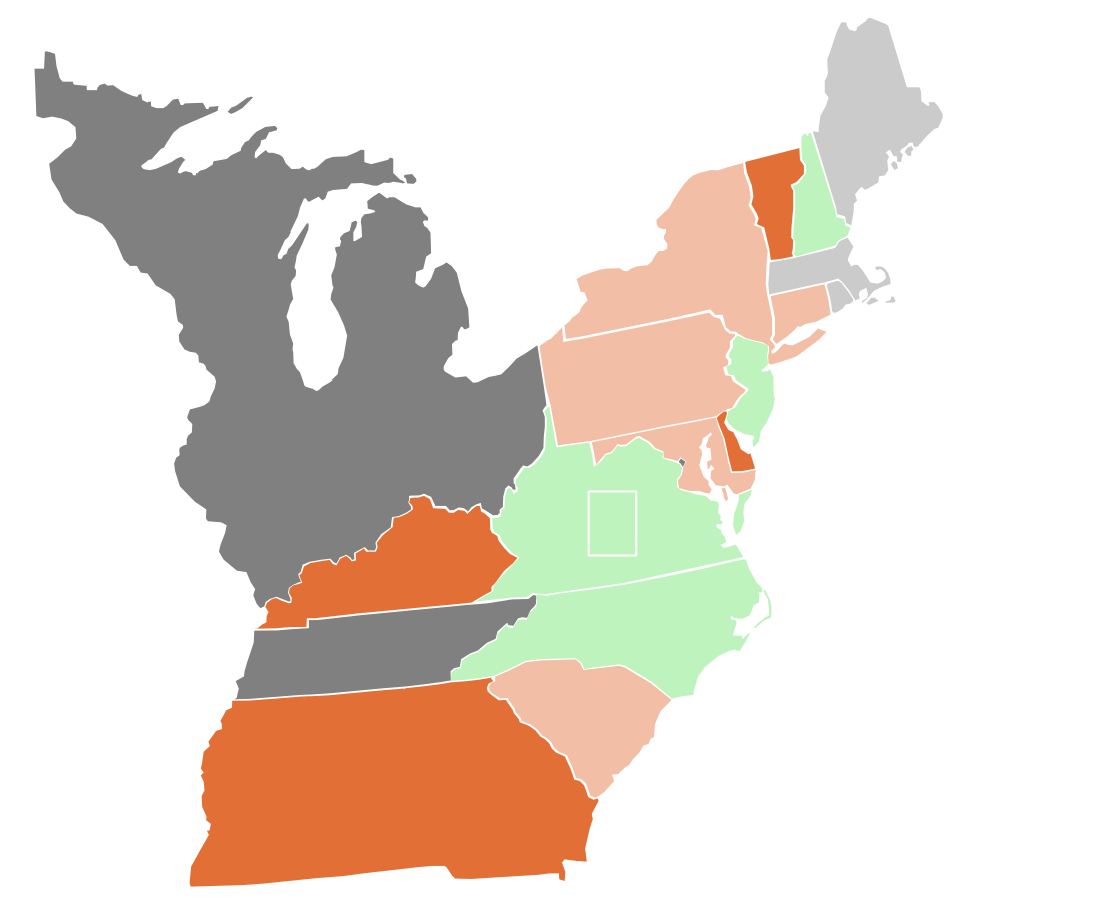Top Qs
Timeline
Chat
Perspective
1794–95 United States Senate elections
From Wikipedia, the free encyclopedia
Remove ads
The 1794–95 United States Senate elections were held on various dates in various states. As these U.S. Senate elections were prior to the ratification of the Seventeenth Amendment in 1913, senators were chosen by state legislatures. Senators were elected over a wide range of time throughout 1794 and 1795, and a seat may have been filled months late or remained vacant due to legislative deadlock.[1] In these elections, terms were up for the senators in Class 3.
This was the first election cycle with organized political parties in the United States, with the Federalist Party emerging from the Pro Administration coalition, and the Democratic-Republican Party emerging from the Anti-Administration coalition.
Remove ads
Results summary
Senate party division, 4th Congress (1795–1797)
- Majority party: Federalist (20)
- Minority party: Democratic-Republican (10)
- Other parties: 0
- Total seats: 30
Change in composition
Summarize
Perspective
Before the elections
Note: There were no political parties in the 3rd Congress. Members are informally grouped here into factions of similar interest, based on an analysis of their voting record.[2]
After the March 31, 1794 special election in Pennsylvania.
| A5 | A4 | A3 | A2 | A1 | |||||
| A6 | A7 | A8 | A9 Ga. Ran |
A10 Ky. Unknown |
A11 N.H. Ran |
A12 N.C. Unknown |
A13 Vt. Ran |
V1 Del. |
P16 S.C. Retired |
| Majority → | |||||||||
| P6 | P7 | P8 | P9 | P10 | P11 | P12 Conn. Retired |
P13 Md. Ran |
P14 N.Y. Ran |
P15 Pa. Retired |
| P5 | P4 | P3 | P2 | P1 | |||||
Results of the elections
| A5 | A4 | A3 | A2 | A1 | |||||
| A6 | A7 | A8 | DR1 N.H. Gain from A |
DR2 N.C. Gain from A |
V1 Del. |
F8 Vt. Gain from A |
F7 S.C. Gain from P |
F6 Pa. Gain from P |
F5 N.Y. Gain from P |
| F4 Md. Gain from P | |||||||||
| P6 | P7 | P8 | P9 | P10 | P11 | F1 Conn. Gain from P |
F2 Ga. Gain from A |
F3 Ky. Gain from A | |
| P5 | P4 | P3 | P2 | P1 | |||||
Beginning of the next Congress
Seven senators who were considered "Anti-Administration" became Democratic-Republicans and eleven "Pro-Administration" became Federalists.
| DR5 Changed |
DR4 Changed |
DR3 Changed |
DR2 Changed |
DR1 Changed | |||||
| DR6 Changed |
DR7 Changed |
DR8 Changed |
DR9 | DR10 | F20 Del. Gain |
F19 | F18 | F17 | F16 |
| Majority → | |||||||||
| F6 Changed |
F7 Changed |
F8 Changed |
F9 Changed |
F10 Changed |
F11 Changed |
F12 | F13 | F14 | F15 |
| F5 Changed |
F4 Changed |
F3 Changed |
F2 Changed |
F1 Changed | |||||
Remove ads
Race summaries
Summarize
Perspective
Except if/when noted, the number following candidates is the whole number vote(s), not a percentage.
Special elections during the 3rd Congress
In these special elections, the winner was seated before March 4, 1795; ordered by election date.
Races leading to the 4th Congress
In these regular elections, the winner was seated on March 4, 1795; ordered by state.
All of the elections involved the Class 3 seats.
Elections during the 4th Congress
There were no elections in 1795 after March 4.
Remove ads
Connecticut
This section needs expansion. You can help by adding to it. (August 2019) |
Delaware (special)
The Delaware special election was held February 7, 1795. Incumbent Senator George Read had resigned to take the position of Chief Justice of the Delaware Supreme Court. Henry Latimer defeated the former Governor of Delaware, Governor of Pennsylvania and Continental Congressmen from Delaware and Pennsylvania by one vote.
Remove ads
Georgia
This section needs expansion. You can help by adding to it. (August 2019) |
Kentucky
This section needs expansion. You can help by adding to it. (August 2019) |
Maryland
This section needs expansion. You can help by adding to it. (November 2022) |
John Henry won election over James Lloyd by an unknown number of votes for the Class 3 seat.[11]
Remove ads
New Hampshire
This section needs expansion. You can help by adding to it. (August 2019) |
New York
This section needs expansion. You can help by adding to it. (August 2019) |
North Carolina
This section needs expansion. You can help by adding to it. (August 2019) |
Pennsylvania
Pennsylvania (special)

Pennsylvania (regular)

Incumbent Federalist Robert Morris, who was elected in 1788, was not a candidate for re-election to another term. The Pennsylvania General Assembly convened on February 26, 1795, to elect a senator for the term beginning March 4, 1795.
South Carolina
This section needs expansion. You can help by adding to it. (August 2019) |
Vermont
This section needs expansion. You can help by adding to it. (August 2019) |
Virginia
Even though neither of Virginia's incumbent's terms were up, both resigned in 1794, leading to two special elections.
This section needs expansion. You can help by adding to it. (August 2019) |
Future-president James Monroe resigned March 27, 1794 to become U.S. Minister to France.
Stevens Thomson Mason was elected November 18, 1794 and would become a Democratic-Republican in the next Congress.
Virginia (special, class 2)

This section needs expansion. You can help by adding to it. (September 2020) |
Incumbent John Taylor of Caroline resigned May 11, 1794.
Henry Tazewell was elected November 18, 1794 and would become a Democratic-Republican in the next Congress.
See also
References
External links
Wikiwand - on
Seamless Wikipedia browsing. On steroids.
Remove ads



